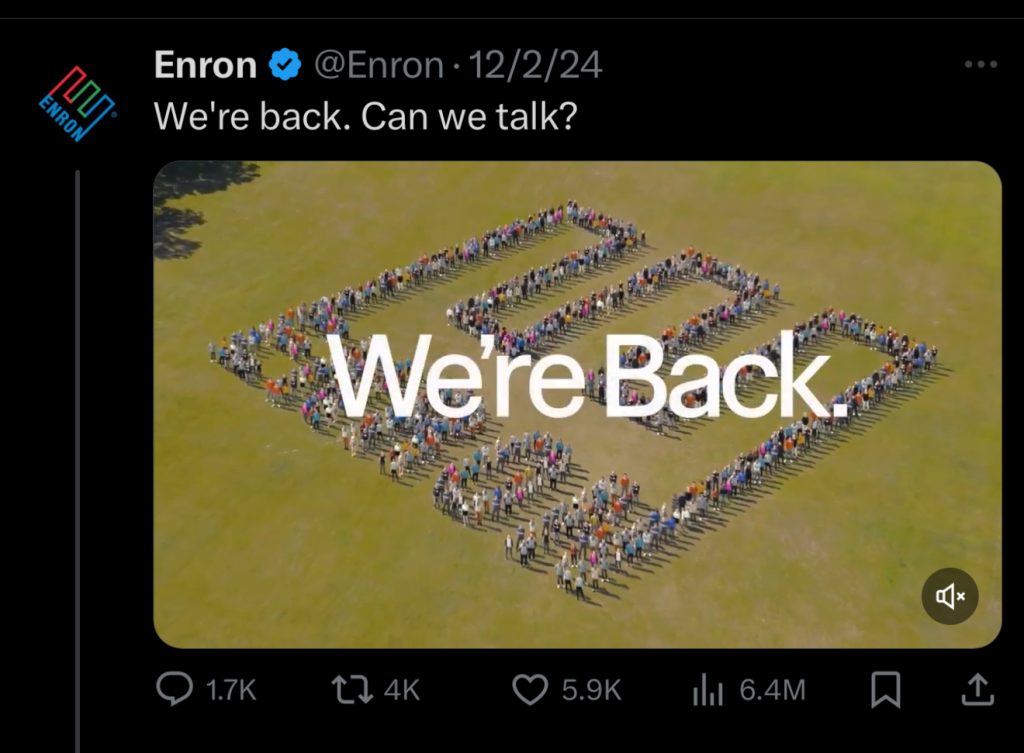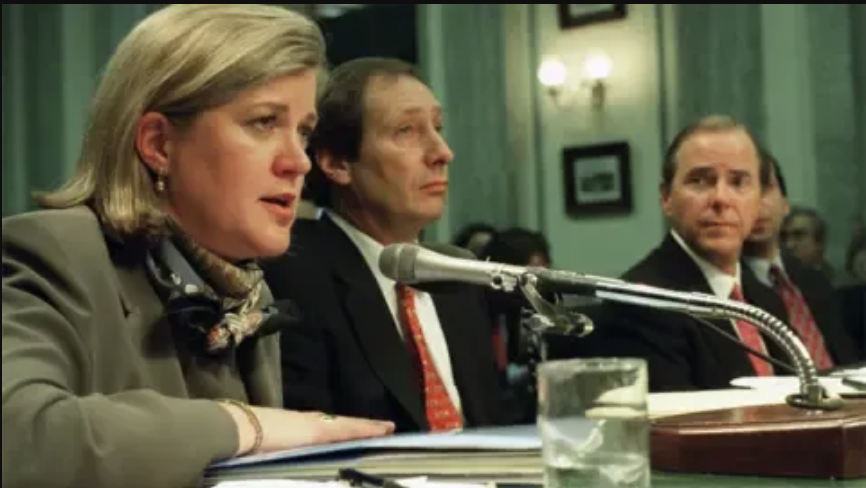The crypto world did a double-take this week as Enron—yes, Enron—launched its own cryptocurrency. Since the company’s scandal in the early 2000s, the brand has been synonymous with one of the most spectacular corporate implosions in history. Once America’s seventh-largest company, it became the face of corporate fraud, blatant financial crimes and a cautionary tale of wild mismanagement.
Yet here we are in 2025, watching Enron trend again. But it’s not the same company. It’s far more intriguing.
And the first signs of it’s unconventional revival emerged in late 2024, when cryptic tweets led to a product announcement: ‘The Egg’—a provocatively designed home nuclear reactor. It spawned conversation and signaled a different type of corporate comeback.

Behind the resurrection is Connor Gaydos, Enron’s CEO and the creative force who gave us Birds Aren’t Real—the viral movement that turned conspiracy theory parody into cultural commentary. Under his direction, Enron is emerging as a bold experiment in brand revitalization, where cultural recontextualization drive its new identity.
Gaydos stumbled upon Enron’s legacy not just as a failed company but as a powerful symbol. A relic of corporate excess that still lingered in public memory. It had some incredible brand assets like its recognizable name and a logo designed by legendary designer Paul Rand, who also created logos for IBM,
ABC, and Steve Jobs’ NEXT computers. Finding that the trademark and branding were unclaimed, Gaydos purchased the rights for $275 and secured the domain name and social handles.
Rather than running from Enron’s infamous past, Gaydos is leaning into it. His strategy? Transform brand infamy into cultural currency through a mix of satire, memeability, conversation, and calculated spectacle.
“We’re Back. Can We Talk?”
Reintroducing itself to the world, perhaps the most striking aspect of Enron 2.0’s revival is its disarmingly direct slogan: “We’re Back. Can We Talk?”
It first popped up on X at the beginning of December and the brand has since used the phrase across its multiple communication tactics.
These five words are powerful and they do something remarkable. They create an invitation for dialogue in a clever and strategic way that feels almost like an art project or open forum for discussion. It recognizes that modern brands are built through active participation with audiences instead of pushed corporate messaging.

By acknowledging its infamous history and explicitly inviting conversation, Enron transforms what was once a PR nightmare into an engagement opportunity.
The brilliance lies in the phrase’s deliberate openness. It’s not making promises or asking for trust. It’s starting a conversation. This approach recognizes that brands are no longer just what companies say they are. They’re what communities collectively decide they are.
The slogan creates a space for curiosity, skepticism, and even criticism—all of which generate the kind of sustained engagement that modern brands need to thrive.
And this conversational approach extends beyond just the slogan. The launch of Enron Coin perfectly exemplifies this conversational strategy. By entering the crypto space—a community known for its passionate discourse and meme-driven culture—Enron 2.0 isn’t just launching a token, it’s opening a new channel of dialogue with one of the internet’s most engaged audiences.
A Redemption Arc for a Notorious Brand?
While most fallen brands try to distance themselves from their past, Enron 2.0 is doing something radically different. Under Gaydos’s direction, the strategy isn’t to rehabilitate. It’s to recontextualize. And it taps into something deeply embedded in American culture: our love for a comeback story.
With this approach, the company’s notorious reputation isn’t a burden, it’s fuel for cultural relevance.

Traditional brand rehabilitation follows a predictable playbook: apologize, rebrand, rebuild trust. But in our time of information overload, attention is more valuable than authority.
By treating Enron’s infamous past as an asset rather than a liability, the company is turning toxic brand equity into cultural capital through strategic irreverence, and an acceptance of past sins.
The brilliance lies in understanding that legacy brands carry tremendous cultural energy—both positive or negative—and that energy can be redirected becoming part of a larger narrative that keeps the brand relevant. It’s a masterclass in what we might call “attention arbitrage”—converting negative brand recognition into cultural momentum.
Through Enron 2.0 we’ll see whether corporate infamy can be memed into legitimacy through participatory storytelling. In doing so, we might see that cultural relevance trumps historical legacy, and that audience participation is more powerful than corporate messaging.
The Strategic Value of Brand Memory
What makes this experiment particularly fascinating is its understanding of brand memory. The Enron name still carries tremendous weight. It’s a cultural touchstone that immediately evokes strong reactions. See above. Rather than trying to erase this history, Gaydos is harnessing it, turning it into an asset.
This approach recognizes that today brand value isn’t just about reputation. It’s about narrative potential. Every piece of content, every reaction, every meme becomes part of a larger story that audiences are actively helping to write. The Enron Coin launch demonstrates this perfectly. Its ambiguity invites speculation, theorizing, and creative interpretation from the community.
Gaydos touches on this in his recent interview with Coindesk.
So, Is Enron 2.0 writing a new playbook for brand building?
While it’s too early to declare success, their approach raises intriguing questions about modern marketing. Let’s break down the key principles at work:
1.) Authenticity Through Absurdity
Instead of fighting public perception, Enron 2.0 amplifies it. They’ve turned “Wait, is this real?” into a strategic advantage. When their home nuclear reactor “The Egg” raised eyebrows, they leaned into the controversy, using social media to fuel rather than quell speculation. The lesson? Sometimes acknowledging the elephant in the room creates more authentic connections than trying to redirect attention.
2.) Community as Co-Creators
Enron 2.0 doesn’t just invite engagement—they create frameworks for it. Their intentionally vague crypto launch isn’t a bug; it’s a feature. By leaving spaces for interpretation, they give their community room to theorize, create content, and shape the narrative. The crypto community isn’t just buying a token; they’re buying into the opportunity to define what Enron could become.
3.) Attention as Strategic Currency
Every shocked reaction, every meme, every debate about “Is this serious?” serves a purpose. Rather than measuring success through traditional brand metrics, Enron 2.0 treats sustained attention as their primary KPI. Their provocative product launches and cryptic announcements aren’t random—they’re calculated to maintain a continuous cycle of speculation and discussion.
4.) Building in Public
Unlike traditional rebrands that emerge fully formed, Enron 2.0 is letting audiences watch the transformation unfold. Their slogan “We’re Back. Can We Talk?” isn’t just clever copywriting—it’s a strategic choice to make brand building a public spectacle. By turning their revival into a kind of performance art, they ensure every step of their journey becomes content for their audience to engage with.
Looking Forward
Where traditional corporate messaging falls flat, Enron 2.0’s approach suggests that the future of brand building might lie in embracing controversy, encouraging speculation, and letting audiences co-create brand meaning. The question isn’t whether Enron can rebuild trust. It’s whether trust matters less than cultural resonance in the attention economy.
What Gaydos understands, and what makes this experiment so compelling, is that modern brand building isn’t about controlling the narrative. It’s about creating spaces for narratives to emerge organically through community participation. Whether Enron 2.0 succeeds in the long term remains to be seen, but it’s already providing valuable lessons about the evolution of brand strategy, specifically brand revitalization.
For marketers watching this unfold, the key takeaway isn’t about the specific tactics—like launching a cryptocurrency—but about the broader shift toward participatory brand building. In a world where audiences are increasingly skeptical of traditional corporate narratives, perhaps the most authentic approach is to embrace the chaos and let the community in on the joke.
Disclaimer: I do not own or hold any of the $ENRON cryptocurrency and have not purchased the coin at the time of publishing. This article is a review of the brand strategy and tactics of Enron 2.0.
